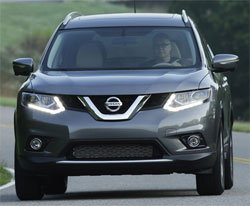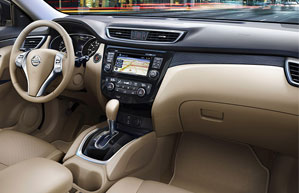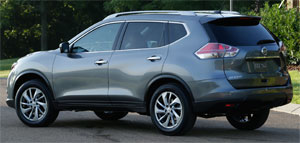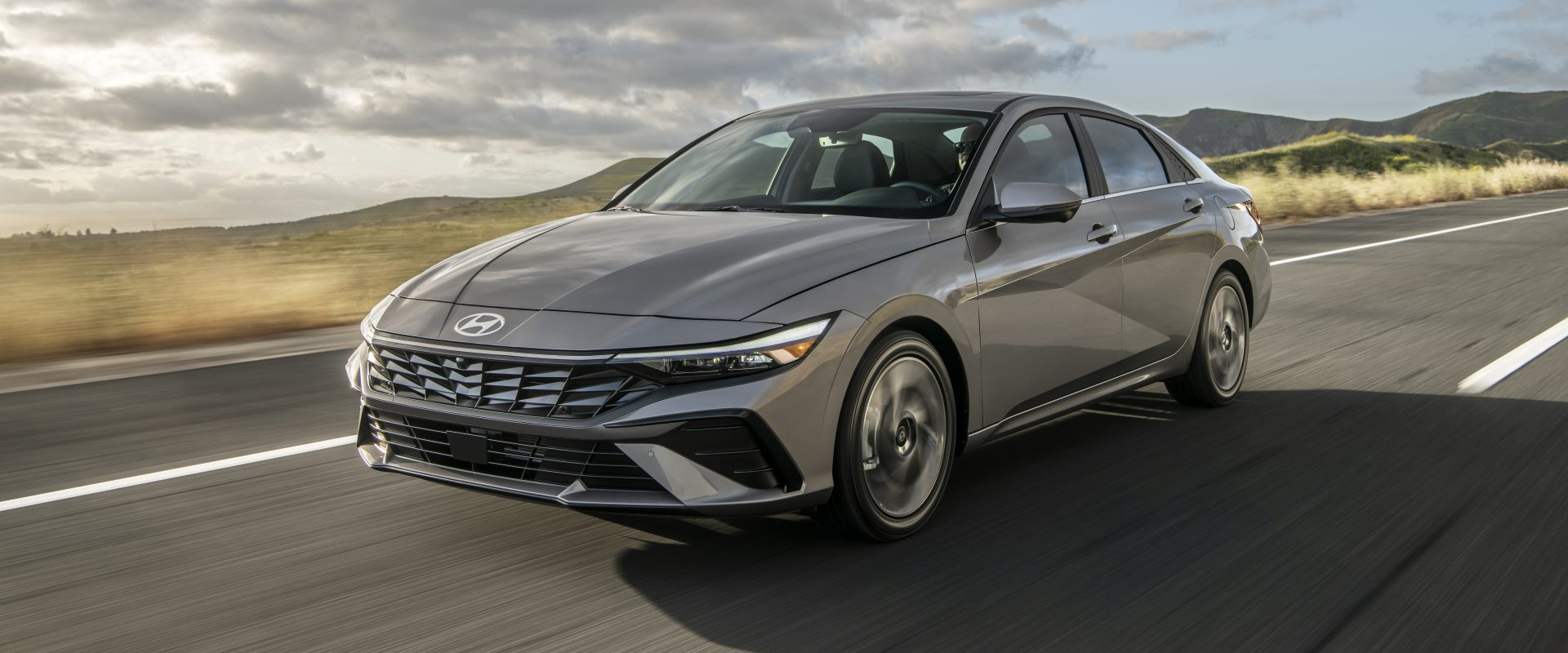2014 Nissan Rogue
After what has to be one of the longest life cycles for a compact crossover, six model years, the second generation of the nissan rogue has finally arrived for 2014. But there’s nothing wrong with taking your time, if the result is worth the wait. Especially if you bring something unexpected to the party. And that’s exactly what the new rogue does.
It may have taken awhile for the 2nd generation, 2014 Nissan Rogue to arrive, but its arrival will not go unnoticed by the rest of the compact crossover segment as Nissan is making a serious attempt to grab a much bigger piece of the market. And we can all agree that in order for that greedy sales grab to take place, the Rogue will need to stand out more than before; so Nissan has brought about much change.
 This is an all new chassis, one that will be sold globally; and while the overall length is actually down an inch to 182.3-inches, wheelbase, width, and height are all up. The upgraded looks feature lots of flowing lines and substantial wheel arches; all very reminiscent of the Rogue’s big brother Pathfinder. But the Rogue’s grille with its narrowed U shape is all its own.
This is an all new chassis, one that will be sold globally; and while the overall length is actually down an inch to 182.3-inches, wheelbase, width, and height are all up. The upgraded looks feature lots of flowing lines and substantial wheel arches; all very reminiscent of the Rogue’s big brother Pathfinder. But the Rogue’s grille with its narrowed U shape is all its own.
And that slick new shape not only looks great but cuts through the air even better and works with an uprated CVT transmission to raise all-wheel-drive Government Fuel Economy Ratings to 25-City, 32-Highway, and 28-Combined. The Energy Impact Score is also very good for a crossover at 11.8-barrels of annual oil consumption with yearly CO2 emissions of 5.3-tons.
And while few mainstream compact crossovers deliver notable driving enjoyment, and none provide extreme levels of comfort, the Rogue has enough of both to keep your commute enjoyable and vacation time very pleasant. Active Trace Control uses selective braking to mitigate understeer and Active Ride Control goes one step further by using brakes and engine torque to reduce both vehicle vibration and body motion.
And there was a definite attempt by Nissan to go more premium on the inside, with very good material quality as well as more features like Nissan Connect.
 But the most unexpected surprise by far is a new 3rd row option for 7-passenger seating. Access is aided by the EZ Flex sliding second row. But, as Rogue is still a compact, 3rd row space is expectedly tight, best fit for small children. Still, most rivals don’t offer comparable versatility. And, even with the 3rd row in place there’s 9.4 cubic-ft. of luggage space. Capacity behind the second row is 32.0 cubic-ft.
But the most unexpected surprise by far is a new 3rd row option for 7-passenger seating. Access is aided by the EZ Flex sliding second row. But, as Rogue is still a compact, 3rd row space is expectedly tight, best fit for small children. Still, most rivals don’t offer comparable versatility. And, even with the 3rd row in place there’s 9.4 cubic-ft. of luggage space. Capacity behind the second row is 32.0 cubic-ft.
And with both rows folded, there’s a mid-size like 70.0 cubic-ft. And a trick divide-‘n-hide cargo management system helps you keep things organized. Working our way forward, new Zero Gravity front seats offer excellent comfort for drives both long and short.
But the newness doesn’t make it all the way forward however, as under the hood is the same QR25DE 2.5-liter I4 as before. There are updates in the name of efficiency, but horsepower and torque are unchanged at 170 and 175 lb-ft. And the usual excessive engine noise that accompanies a CVT is on full display as you work your way from a stop light, or in our case, down a drag strip.
Power is a tad soft at launch, but once those RPM’s reach their steady peak it feels fairly decent. The simulated shifts feel more like bouncing off a rev limiter and don’t really seem to help times. 0-60 takes a leisurely 8.9-seconds, with a slow quarter mile of 16.9-seconds at 83 miles-per-hour.
The fully independent front and rear suspension with stabilizer bars and twin tube shocks performs above average, provided you keep inputs smooth thus keeping the aggressive traction control from engaging. Except for some pretty hard nose dive, braking performance is also good, with stops averaging 126-feet.
 Safety conscious families can opt for one of the two Premium packages to add a Blind Spot Warning system, as well as Lane Departure Warning and Moving Object detection.
Safety conscious families can opt for one of the two Premium packages to add a Blind Spot Warning system, as well as Lane Departure Warning and Moving Object detection.
As for prices, they slot in nicely against compact CUV rivals, starting at just $23,350. Top level SL trim begins at $28,930; and all-wheel-drive can be added to any Rogue for 13-hundred-50 dollars more.
While it was definitely long overdue for a re-design, it looks to have been worth the wait; as the 2014 Nissan Rogue appears to be a much more serious player in the segment. That’s good news for Nissan and good news for buyers looking for unexpected largess in a compact crossover.
Specifications
- Engine: 2.5-liter I4
- Horsepower: 170
- Torque: 175 lb-ft.
- 0-60 mph: 8.9-seconds
- 1/4 mile: 16.9 seconds @ 83 mph
- EPA: 25 mpg city/ 32 mpg highway
- Energy Impact: 11.8 barrels of oil/yr
- CO2 Emissions: 5.3 tons/yr
2024 Hyundai Elantra
Basic Transportation At Its Best…And That Is A Compliment
For those of you who write in every week bemoaning the fact that all we seem to do around here is test incredibly expensive cars and EVs that only the very well to do can afford, this one’s for you. It’s a commuter and budget friendly mainstay from Hyundai, the compact Elantra sedan. And, it has been nicely updated for 2024.
We clearly do enjoy driving high-performance machines and ultra-luxury rides around here, but like most of you, when it comes time to drive home at the end of a long workday, we do so in something much more practical and affordable, like this 2024 Hyundai Elantra sedan.
If you’re thinking the front end has gotten more aggressive, you’re right. Hyundai calls it a “Shark Nose” theme, and we’re guessing they were thinking more Great White than Hammerhead, though Megamouth shark would also apply. It helps for a low and wide look; more substantial than the typical compact. Other additions for ’24 include slimmer daytime running lights, revised stainless steel Hyundai emblem, reshaped front fenders, sport sedan-style rear diffuser with silver trim; a parametric pattern added to the C-Pillar, and new LED taillights that take up a lot more space on the highly sculpted decklid. Plus, new wheel designs in sizes ranging from 15- to 18-inches.
Standard engine in SE, SEL, and Limited grades is this naturally aspirated 2.0-liter I4 with 147 horsepower and 132 lb-ft of torque. Even with no hybrid assistance, it gets substantial Government Fuel Economy Ratings of 31 City, 40 Highway, and 34 Combined; we averaged a great 38.6 mpg of Regular.
Those high fuel economy numbers mean acceleration times are pretty high as well. It was in no particular hurry to get off the line at our test track, as after a slight jolt of power, it felt pretty sluggish going down the track, taking us a lengthy 9.4 seconds to hit 60 mph. Hyundai’s Intelligent Variable Transmission has some realistic simulated gear shifts built in, and they not only provided the feel of a true automatic, but kept engine noise from becoming overbearing. And while this 2.0-liter may not be a house-on-fire off the line, it has no problem keeping up with traffic, and feels like just the perfect amount of power for a practical and safe commuter car.
There are other engine options too. Two choices if you want to go faster, a 1.6-liter turbo with 201 horsepower in the Elantra N Line, and a 276-horsepower turbocharged 2.0-liter for the Elantra N; plus, one with even better fuel economy, a 1.6-liter hybrid with a 139 horsepower total output.
And despite some significant understeer, there was good feel through the cones of our handling course, both in steering and chassis feedback. We wouldn’t quite call it “point and shoot,” but it responded to inputs fairly quickly, with only moderate body roll. All-in-all, when it comes to performance, it doesn’t claim to bring a whole lot to the table, but does clearly overachieve with what it does bring.
And Hyundai is always overachieving when it comes to packing in features, yet has found a way of keeping things refreshingly simple with a good mix of touchscreen and manual controls. Lots of space too, both up front in the surprisingly wide front buckets, and in the rear bench with ample room for three. Updates for all Elantra interiors include softer materials on the door panels, upgraded instrumentation and additional charging ports, plus a surround view monitor and new H-Tex simulated leather for Limited trim.
Elantra pricing starts with an SE at $22,775, the SEL comes in at $24,725, Limited begins at $28,215, and the sporty N Line starts at $29,615. If you’re interested in the hybrid, base Blue starts at $27,400 with Limited at $30,600.
Some might say there’s not a whole lot that’s earth shaking about the 2024 Hyundai Elantra, but that’s mostly why we like it so much. When it comes to just delivering good, basic transportation with a high dose of unexpected amenities, Hyundai delivers once again.
Specifications
- Engine: 2.0-liter I4
- Horsepower: 147
- 0-60 mph: 9.4 seconds
- 60-0 Braking: 111 ft (avg)
- MW Fuel Economy: 38.6 MPG (Regular)
- Transmission: IVT
- Torque: 132 lb-ft
- 1/4 Mile: N/A (Track Maintenance)
- EPA: 31 City / 40 Highway / 34 Combined







